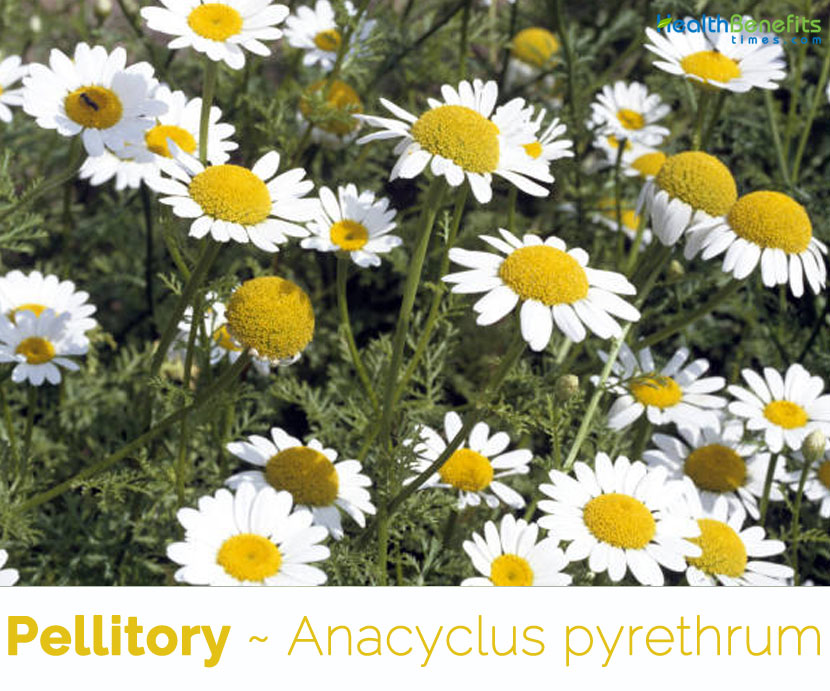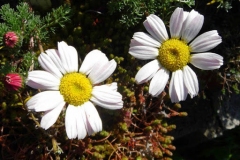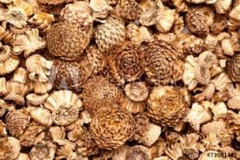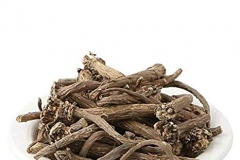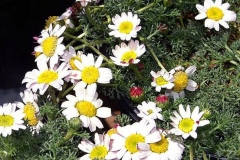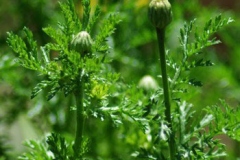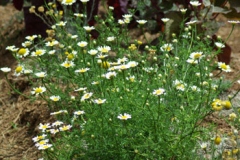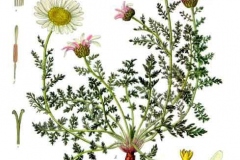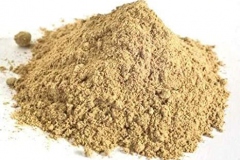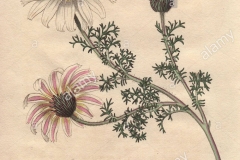Plant Description
Pellitory is a small, hairy, stem less, herbaceous perennial plant that normally grows about 3-4 feet tall. The plant is found growing in alpine or rock garden. Root is almost cylindrical, brown in color, 7-15 cm in length, very slightly twisted, tapering and often crowned with a tuft of grey hairs, having aromatic odor and pungent taste. Externally it is brown and wrinkled, with bright black spots. The plant has numerous stems with downy branches. It is a prostrate herb that looks like Chamomile to a greater extent. The stems lie on the ground and rise erect towards the ends. Each of the stem bears one large flowers at branch-ends, with yellow colored disk, white colored rays and tinged with purple beneath. Leaves are alternate, smooth and pinnate. They are pale green in color with deeply cut segments. They have large white flowers with yellow centers. Fertile flowers are followed by obovate achene.
Pellitory Facts
| Pellitory Quick Facts | |
|---|---|
| Name: | Pellitory |
| Scientific Name: | Anacyclus pyrethrum |
| Origin | North Africa, elsewhere in the Mediterranean region, in the Himalayas, in North India |
| Shapes | Obovate achene |
| Taste | Persistent pungent, bitter taste |
| Health benefits | Loss of Libido, Pharyngitis & Sore Throat, Toothache, Epilepsy & Seizures, Pyorrhea, Impotency & Erectile dysfunction, Common Cold, Childhood apraxia of speech (CAS) & Delayed Speech Development |
| Name | Pellitory |
|---|---|
| Scientific Name | Anacyclus pyrethrum |
| Native | North Africa, elsewhere in the Mediterranean region, in the Himalayas, in North India, the Levant and in certain regions in the Arabian peninsula |
| Common Names | Algerian pellitory, Akarkara plant (India), Longwort, Mayweed, Mount Atlas daisy, Pellitory, Pellitory of Spain, Pyrethrum root, Roman pellitory, Roman pyrethrum, Spanish camomile, Spanish pellitory, Roman pellitory, Spanish chamomile |
| Name in Other Languages | Afrikaans: Pellitory Albanian: Pellitory Amharic: Ye’ākali bik’ati inik’isik’asē (የአካል ብቃት እንቅስቃሴ) Arabic : Aud el‘attas (اود يل اتتاس), Akar karha (اكار كارها), اغارغارها Agargarha, eaqir qarhanaan (عاقر قرحا), erq alqarh (عرق القرح) Armenian: Henaket (հենակետ) Azerbaijani: Kəllə Bengali : Akarkara, pellitory-ˈpeliˌtôrē, Bertram Bulgarian: Pellitory-ˈpeliˌtôrē Burmese: Kyawwattantarr (ကျောက်တံတား), kwk k rar (ကွက္ကရာ) Catalan : Pelitre, Piretre africà Chinese: Fǎ lǐxué (法理学) Croatian: Pellitory Czech: Bertrám římský, peletární Danish : Bertramsrod, pellitory Dutch: Arikaanse pyrethrum, Atlasmadeliefje, Marokkaanse kamille, korrelig, Roomse bertram, Roze kamille, Speekselkruid, Vuurkruid English: Algerian pellitory, Akarkara plant (India), Longwort, Mayweed, Mount Atlas daisy, Pellitory, Pellitory of Spain, Pyrethrum root, Roman pellitory, Roman pyrethrum, Spanish camomile, Spanish pellitory, Roman pellitory, Spanish chamomile, Bertram Esperanto: Pellitory Estonian: Pellitory Filipino: Pellitory Finnish: Raimikki, Pellitory, Marokonraimikki French: Pyrèthre, Pyrèthre d’Afrique, Pyrèthre salivaire, Œil de bouc, Pariétaire d’Espagne, Camomille marocaine, Pellitory, Oeil de bouc Georgian: Narcheni (ნარჩენი) German: Franzosenwursel, Marokkokamille, Römische Bertramswurzel, Römischer Bertram, Speichelwurz , Zahnwurzel, Morokko-Bertram, Pellitory, Mehrjähriger Bertram Greek: Anakiklos o pyrethros (Ανάκυκλος ο πύρεθρος), Pyrethron (Πύρεθρον), eídos tsiknídas (είδος τσικνίδας) Gujarati: Akorkaro, Pēlīṭōrī (પેલીટોરી) Hausa: Pellitory Hebrew: אגן Hindi: Akarkara (अकरकरा), Akkal Kara, pellitory-ˈpeliˌtôrē Hungarian: Fogfájógyökér, Piretrum, Római Bertram, Pellitory Icelandic: Grindarhol Indonesian: Pellitory Irish: Pellitory Italian: Piretro romano, parietaria Japanese: Anakikurusu (ア ナキクルス), Anakikurusu piresurumu (ア ナキクルス・ピレスルム), Piretoriumu (ピレトリウム), Peritorī (ペリトリー) Javanese: Pelet Kannada: Akkalakara, Aakala kaare, Pelliṭari (ಪೆಲ್ಲಿಟರಿ) Kazakh: Tüyirşik (түйіршік) Korean: pelliteulon (펠리트론), pelli toil (펠리 토리) Kurdish: Pellitory Lao: Hophak (ຫໍພັກ) Latin: Herbae muralis Latvian: Pellitory Lithuanian: Pinigai Macedonian: Peletorija (пелеторија) Malagasy: Pellitory Malayalam: Akkikkaruka Akkravu, Pellēṟṟaṟi (പെല്ലേറ്ററി) Marathi: Akkalkara, Akkal Kadha Maltese: Pellitory Marathi: Pēlīṭarī (पेलीटरी) Mongolian: Urel (үрэл) Nepali: Akarakala (Akarkala), Akarkara (अकलकरा), pallitaree (पल्लिटरी) Norwegian: Pellitory Oriya: ପେଲିଟୋରୀ | Pashto: ناڅاپي Persian: عاقرقرحا , بابونه زرد Polish: Bertram lekarski, Pellitory Portuguese: Pellitory Punjabi: Akarkara, Pailiṭarī (ਪੈਲਿਟਰੀ), Akarakarā (ਅਕਰਕਰਾ) Romanian: Pellitory Russian: Anatsiklus piretrinovyj (Анациклус пиретриновый), Anatsiklus piretruma (Анациклус пиретрума) , Bertram (Бертрам), Nemetskaia romaška piretrinovaia (Немецкая ромашка пиретриновая), Romaška sljunogonnaia (Ромашка слюногонная), slyunogon lekarstvennyy (слюногон лекарственный), postennica (постенница) Sanskrit: Agragrahi, Akarakarabhah, , Akarkara (अकरकरा), Bhringraj kul Serbian: Pellitori (пеллитори) Sindhi: ڇڪتاڻ Sinhala: Peliṭari (පෙලිටරි) Slovenian: Pellitory Spanish: Pelitre romano, Raíz de pelitre romano, pelitre, parietaria Sundanese: Peletakan Swedish: Bertram, Romersk Bertram, Pellitory Tajik: Palang (паланг) Tamil : Akkirakkaram (அக்கரகாரம்), Akkalkara, Pelliṭṭari (பெல்லிட்டரி), pellitory-ˈpeləˌtôrē Telugu: Akarakaramu, Akkalakarra (అక్కలకర్ర) Thai: Kot kak kra (โกฐ กักกรา), pellitory-ˈpeləˌtôrē Turkish: Pire out, Pellitory Ukranian: Pellitorna (пелліторна) Urdu: Aaqarqarha, ﺋﺎﻗﺮﻗﺮﺣﺎ, پیلیٹری Uzbek: Qafas Vietnamese: Viên Welsh: Pellitory Zulu: Ipellitory |
| Plant Growth Habit | Small, hairy, stem less, herbaceous perennial plant |
| Growing Climates | Alpine or rock garden |
| Plant Size | 3-4 feet |
| Root | Almost cylindrical, brown in color, 7-15 cm in length, very slightly twisted and tapering and often crowned with a tuft of grey hairs, having aromatic odor and pungent taste. Externally it is brown and wrinkled, with bright black spots |
| Leaf | Leaves are smooth, pinnate and alternate, with cutted segment |
| Flower | Large white flowers with yellow centers |
| Fruit Shape & Size | Obovate achene |
| Propagation | By seed, by division of roots and by cuttings |
| Plant Parts Used | Dried root, flower, leaves, essential oil |
| Flavor/Aroma | Slight aromatic smell |
| Taste | Persistent pungent, bitter taste |
| Available Forms | Capsules, powder |
| Health Benefits |
|
| Other Facts |
|
Health benefits and Medicinal Uses of Pellitory
Anacyclus Pyrethrum is mainly advantageous for men’s problems. It helps treating many hazardous diseases. Here are some main medicinal uses and health benefits of Pellitory given underneath
1. Loss of Libido
Pellitory has aphrodisiac, libido stimulant, and spermatogenic actions. It inspirations the secretion of androgens and increases their production. Alkyl-amide, the main alkaloid in Pellitory root increases the production of testosterone. It may likely to work on hypothalamus stimulation due to Alkyl-amide. Overall, Pellitory boosts fertility, increase spermatozoa count, and improves libido in male. (1)
As per Ayurvedic theories, Anacyclus Pyrethrum roots acts as libido stimulant for men because of its action on brain and nerves. It encourages desire and increases blood supply to genitals.
2. Pharyngitis & Sore Throat
Gargle with Pellitory water is also helpful. For this, boil 10 grams Pellitory root in 250 ml water. Gargle with this water to get relief from pharyngitis. It is also beneficial for toothache and gum diseases.
3. Toothache
Gentle massage of Pellitory root powder with Camphor helps in toothache. It is also used with black pepper, henbane and Vaividang for reducing toothache.
4. Pyorrhea
Pellitory root powder is mixed with mustard oil and used in the treatment of pyorrhea.
5. Common Cold
Anacyclus Pyrethrum root powder with black pepper and long pepper helps in common cold. Pellitory has antiviral properties, so it decreases all symptoms of flu and alleviates nasal congestion.
6. Childhood apraxia of speech (CAS) & Delayed Speech Development
Gentle massage of tongue with 125 mg of Pellitory root powder mixed with honey helps improving speech in children. Its effects potentiate when 125 mg Sweet flag is also added in this mixture.
7. Epilepsy & Seizures
In Ayurveda, Anacyclus Pyrethrum is used as adjuvant in management of epilepsy and seizures. Research has shown that its root extract has protective action, so it may help preventing seizures.
8. Impotency & Erectile dysfunction
Anacyclus Pyrethrum or Akarkara is good remedy for treating Impotence & Erectile dysfunction. It has same function as SILDENAFIL has, but it does not increase blood pressure. It also has lesser side effects as compared to SILDENAFIL.
Akarkara efficacy reduces after a few weeks if it is used alone. Thus, it should be used along with Ashwagandha and Velvet bean powder for maximum benefits.
Traditional uses and benefits of Pellitory
- Root is a pungent acrid herb that encourages the salivary glands and irritates the tissues, thus increasing blood flow to the area.
- It is used externally to treat toothache, facial neuralgia and chronic catarrh.
- In Ayurvedic medicine the root is considered to be tonic and is used in the treatment of paralysis and epilepsy.
- Diluted essential oil in the root is used in mouthwashes and to treat toothaches.
- Chewing the flower head produces an analgesic action and relieves toothache.
- Flowers are beneficial in cleansing the mouth. It provides relief in swollen and painful gums.
- It is a good herbal remedy in treating impotence and erectile dysfunction.
- It is combined with honey and Acorus Calamus in treating Childhood Apraxia of Speech.
- Gentle massage of tongue with this paste improves voice.
- Pellitory root is beneficial in Sore Throat. The root is boiled and the water is for Gargles.
- It increases circulation of blood and relieves in rheumatic arthritis.
- It supports digestion by stimulating the secretion of digestive juices.
- Diuretic action of Pellitory is useful in detoxifying the body by increasing the frequency & quantity of urine.
- It calms the Nervous system and helpful in treating Nervous disorders.
- The antimicrobial action of Pellitory helps in destroying the worms in the intestines.
- It fights Coryza.
- Medicated oil is prepared using the root of Pellitory plant and this medicated oil is applied externally to treat cases of paralysis and nervine disorders like tremors of the body, sciatica etc.
- Decoction is prepared from the root is used for gargling in cases of gingivitis, oral ulcers, dental caries and pain in the tooth.
- Paste prepared from the root is applied over the area having wound associated with pus.
- Fresh juice prepared from the root of the plant is administered as ‘Nasya’ (drops administered through nostrils) to treat rhinitis.
- Medicated oil prepared using the root of Pellitory is applied externally over the joints of the body in case of joint pain.
- Cold infusion prepared from the plant is given in a dose of 30-40 ml in cases of slow heart beat/ heart rate.
- Powder prepared from the dried root of Anacyclus pyrethrum is given 1 gram with milk to treat erectile dysfunction and premature ejaculation.
- Cold infusion of the root is given in a dose of 30-40 ml in cases of general debility caused by nerve weakness.
Home remedies using Pellitory
Root powder for toothache: Pinch of root powder is taken and kept in the base /gum of the affected teeth/tooth ache. This gives relief within 5-10 minutes. This will reduce the swelling and pain also.
Flower head powder/paste for erectile dysfunction: Flower head paste or powder (500 mg) is cooked with milk and given once or twice a day. This acts as a sexual stimulant, delays the ejaculation and promotes sexual power/desire.
Root powder immersed in oil as sexual stimulant: 5 gram of root powder is kept on immersion with 60 ml of coconut oil in sunshine for 6-8 days. Then it is filtered and stored. This traditional oil is applied over the genitalia in cases of loss of erectile ability. 15-20 days medication is claimed to be of good effect in this respect.
Hot infusion for sore throat: Pinch of Pellitory flower head or root powder is added to a cup of water and kept for a while. This is used to gargle in cases of tonsillitis and sore throat.
Root powder with ghee for urinary retention: Pinch of root powder is rubbed with 1 spoon of ghee and licked twice with an interval of 30 minutes. This flushes out the urine within one hour.
Ayurvedic Health benefits of Pellitory
- Depression: Take 2 ml plant extract of Pellitory with lukewarm water. Have it once a day.
- Ascaris: Make a root decoction of Pellitory. Drink 10 ml of it once a day.
- Eyes: Use the root decoction of Pellitory to wash your Eyes.
- Libido Loss Male: Take 5 tablespoons Withania Somnifera, 5 tablespoons Asparagus Racemosus, 1.5 tablespoons Dodder, 2 pinches Saffron, 1 tablespoon Anacyclus Pyrethrum, 1 tablespoon Nutmeg and 1/2 tablespoon Marsh Orchid. Grind all ingredients together. Have half teaspoon with milk daily.
- Premature Ejaculation: Mix the powder of Anacyclus, Damiana and Cloves in equal quantity. Take two tablespoon with a cup of milk twice a day.
- Headache: Grind the roots and apply on the forehead, to relieve a headache. Keep it in between the teeth to relieve a headache. On chewing it, the saliva is secreted and relieves a toothache.
- Epilepsy: Grind it in vinegar, add honey and lick around 5 to 10 mg of this medicine to control the attacks of epilepsy. It is beneficial in case of fits if given along with Brahmi quash.
- Stammering: Add the powder of its root with black pepper and honey, rub one gram of this mixture on the tongue to remove the dryness. It cures lisping of the tongue. It should be used for 4 to 6 weeks.
- Toothache: Take equal amount of Pellitory roots and camphor and grind it, use this powder to brush the teeth, it cures all types of a toothache. Gargle with the quashing of the root to cure a toothache and it also strengthens the looseness of teeth.
- Throat problems: Gargles with this water are beneficial in case of tongue, teeth and throat problems.
- Bad Odor: Take equal quantities of Pellitory roots, Nagarmotha, roasted plum, black pepper, rock salt, brush the teeth every day with this powder. It cures all types of dental problem and bad odor.
- Heart disease: Add Arjun chhal and Pellitory roots powder in equal quantities grind it nicely and take half spoon twice daily to cure anxiety, palpitation, shivering, pain, and weakness. Take 20 to 25 mg of Kullajan, South, and Pellitory roots and boil in 400 ml of water till it reduces to one-fourth quantity. This is beneficial in case of heart diseases.
- Hiccups: Take one gram of Pellitory roots powder and lick with honey; it has an instant effect in case of hiccups.
- Fever: Cook this powder in olive oil and massage the body, it helps in perspiration and bring down the temperature. Give 4 to 6 drops of Chirayata with 500 mg of this powder to cure chronic fever.
- Respiration: Sieve the Pellitory root with a cloth and smell it to remove the blockages in respiration.
- Acidity and loss of digestive fire: Take one gram of each of Shunthi powder and Pellitory, and take it to cure acidity and loss of digestive fire.
- Sciatica: Add the Pellitory root powder in walnut oil and massage the affected area.
- Wounds: Make 100 ml of quashing with Ushva and take it in case of wounds. Mix Pellitory root powder and mustard powder with honey and apply on the tongue to cure partial body pain.
Precautions
- This oil should not be used internally, except under professional supervision.
- Long term use of Pellitory is not recommended. Generally, it is used for a period of 1 to 3 weeks.
- Use of Pellitory is not advised, if already suffering with Ulcers, Acidity, Gastritis, Ulcerative Colitis, Burning Sensation, History of mouth ulcers and Inflammatory Bowel Disease.
- Higher dosage may cause Acidity, Heartburn, Mouth Ulcers, Burning Sensation and Excessive Saliva production.
- Pellitory increases menstrual flow and uterine contractions. Do not take Pellitory during Pregnancy.
- Pellitory reduces the production of milk. It is not advised for breastfeeding mothers.
- If root powder is given in a dose more than 0.5 to 1 gm., it causes Nausea, Bleeding, and increase in heart rate, unconsciousness and salivation.
References:
https://pfaf.org/user/Plant.aspx?LatinName=Anacyclus+pyrethrum
https://en.wikipedia.org/wiki/Anacyclus_pyrethrum
https://npgsweb.ars-grin.gov/gringlobal/taxonomydetail.aspx?103836
https://enacademic.com/dic.nsf/enwiki/454400
http://www.theplantlist.org/tpl1.1/record/gcc-78683
https://www.flowersofindia.net/catalog/slides/Spanish%20Chamomile.html
https://www.planetayurveda.com/library/akarkara-anacyclus-pyrethrum/
https://gd.eppo.int/taxon/ANYPY
https://botanical.com/botanical/mgmh/p/pellit19.html
https://www.japsonline.com/admin/php/uploads/1818_pdf.pdf


